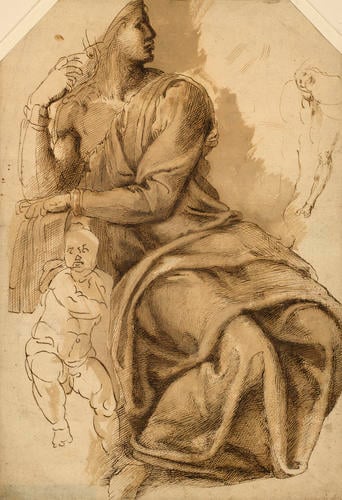-
1 of 253523 objects
A seated draped figure c.1520-1600
Pen and ink, brush and ink | 41.3 x 28.2 cm (sheet of paper) | RCIN 990409

Copy after Michelangelo Buonarroti (Caprese 1475-Rome 1564)
A seated draped figure c.1520-1600

Copy after Michelangelo Buonarroti (Caprese 1475-Rome 1564)
A seated draped figure c.1520-1600


-
A drawing of a seated figure, heavily draped, with a child; sketches of a torso and of legs.
This a copy of a drawing by Michelangelo in the British Museum (1887,0502.115). J. Wilde (Popham and Wilde 1949, no. 462) initially assumed the original to be a study for the Sistine Ceiling, but four years later (Italian Drawings in the British Museum: Michelangelo and his Studio, 1953, no. 29) argued instead that the elongated proportions and ‘plastic mass’ are more reminiscent of Michelangelo’s sculptures for the Medici tomb in San Lorenzo, Florence. Subsequent commentators have accepted the implied date of about 1520-25. C. de Tolnay suggested the figure might represent a Madonna or a personification of Charity (Corpus 97).
The small sketch of part of a torso at upper right is a partial copy of another Michelangelo drawing, in the Teylers Museum, Haarlem (A.23), a study for the figure of St Lawrence in the Last Judgment, c.1537-38. Below are slight sketches of legs, of unidentified origin.
On the verso is the pen inscription ‘Michelangolo Bonarotti’, and an indication of a number code partially covered by the mount, in the hand associated with the English seventeenth-century dealer William Gibson, whose inscriptions and characteristic ‘price codes’ can be found on at least 51 drawings in the Royal Collection. Like many other drawings with an English seventeenth-century provenance, the top corners of this sheet have been cropped, perhaps to be placed in a decorative mount. This cropping could be indicative of a particular collector or could represent a more general fashion adopted by English collectors at that time; some 14 of the 51 drawings in the Royal Collection with Gibson inscriptions have been cropped in this way (though none of the drawings with Lanier marks have been cropped), and a further 29 Italian Renaissance drawings without collectors' marks have been shaped in the same manner. It is likely that all these drawings were acquired for the Royal Collection in the seventeenth century, most probably during the reign of Charles II.Provenance
From the collection of William Gibson; probably acquired by Charles II. Listed in George III's Inventory A, c.1800, p. 44, 'Mich: Angelo Buonarroti/ Tom. I', among ‘41 to 46. Studies for Prophets; Sybills &c. in the Cieling / of the Capella Sistina; at the Vatican.'
-
Creator(s)
Previously attributed to (artist)Acquirer(s)
-
Medium and techniques
Pen and ink, brush and ink
Measurements
41.3 x 28.2 cm (sheet of paper)